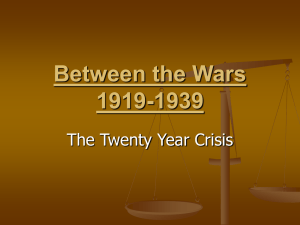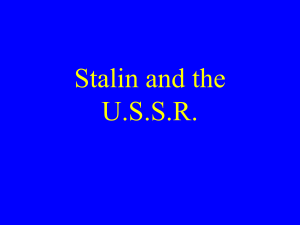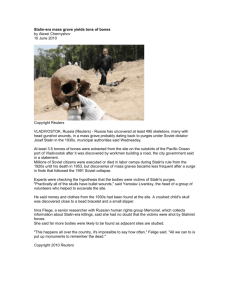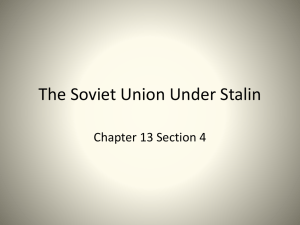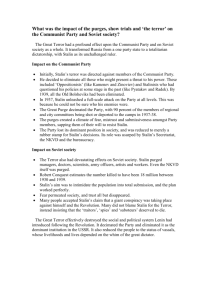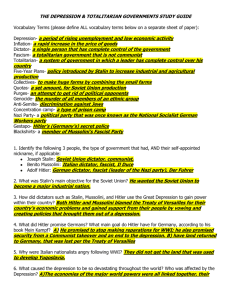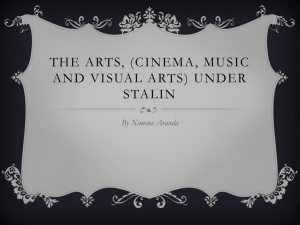Stalin Worksheet
advertisement
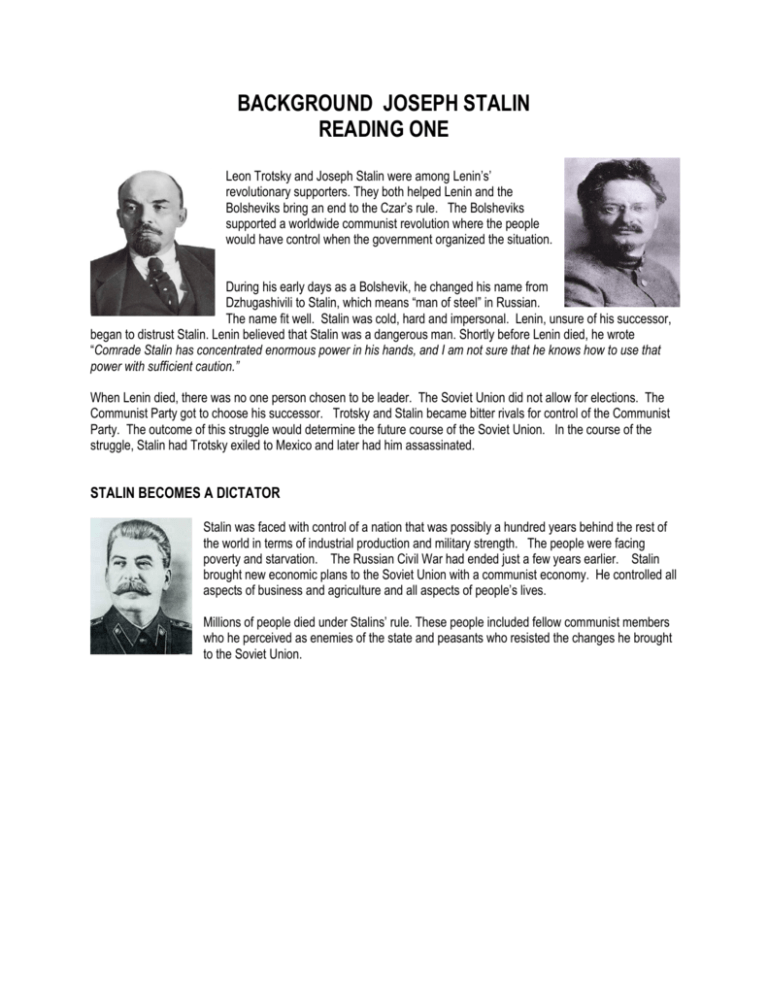
BACKGROUND JOSEPH STALIN READING ONE Leon Trotsky and Joseph Stalin were among Lenin’s’ revolutionary supporters. They both helped Lenin and the Bolsheviks bring an end to the Czar’s rule. The Bolsheviks supported a worldwide communist revolution where the people would have control when the government organized the situation. During his early days as a Bolshevik, he changed his name from Dzhugashivili to Stalin, which means “man of steel” in Russian. The name fit well. Stalin was cold, hard and impersonal. Lenin, unsure of his successor, began to distrust Stalin. Lenin believed that Stalin was a dangerous man. Shortly before Lenin died, he wrote “Comrade Stalin has concentrated enormous power in his hands, and I am not sure that he knows how to use that power with sufficient caution.” When Lenin died, there was no one person chosen to be leader. The Soviet Union did not allow for elections. The Communist Party got to choose his successor. Trotsky and Stalin became bitter rivals for control of the Communist Party. The outcome of this struggle would determine the future course of the Soviet Union. In the course of the struggle, Stalin had Trotsky exiled to Mexico and later had him assassinated. STALIN BECOMES A DICTATOR Stalin was faced with control of a nation that was possibly a hundred years behind the rest of the world in terms of industrial production and military strength. The people were facing poverty and starvation. The Russian Civil War had ended just a few years earlier. Stalin brought new economic plans to the Soviet Union with a communist economy. He controlled all aspects of business and agriculture and all aspects of people’s lives. Millions of people died under Stalins’ rule. These people included fellow communist members who he perceived as enemies of the state and peasants who resisted the changes he brought to the Soviet Union. A TOTALITARIAN STATE READING TWO Lenin and Trotsky wanted to unite Communists around the world. Stalin, however, focused on Russian development. He coined the phrase “socialism in one country” to describe his aims of perfecting a Communist state in Russia. The Soviet Union was behind the rest of the world in terms of both agricultural and industrial production. To realize his vision, Stalin would transform the Soviet Union into a totalitarian state. The term totalitarianism describes a government that takes total, centralized state control over every aspect of a person’s of public and private life. Totalitarian leaders, such as Stalin, take advantage of the insecurities of a nation and appear to provide a sense of security and give a direction for the future. Totalitarianism is the opposite of what western democracies like the United States value the most. Western values such as human reason, freedom, human dignity, and the worth of the individual are not encouraged in a totalitarian government. Totalitarianism relies on absolute authority of the government by one political party. Often, one dynamic leader comes forward. He helps unite the people toward a common vision and insists on unconditional loyalty and uncritical support. Leaders often justify their violent actions in the name of progress and use radios, newsreels and loudspeakers to spread their words. In a totalitarian society, the government controls businesses, family life, housing, education and religion. Their goal is to build up military weapons and will use force and intimidation to shut up their critics. Other totalitarian government besides the Soviet Union emerged in the twentieth century in the 1920’s and 1930’s, two other European dictators Hitler in Germany and Mussolini in Italy – were shaping their visions of a totalitarians state. Under Stalin’s totalitarian regime, the government controlled every aspect of the worker’s life. Officials chose the workers, assigned the jobs and determined their working hours. Workers needed the police’s permission to move. The secret police were ready to imprison or execute those who did not contribute to the Soviet economy; these forceful means of making the Soviet Union a modern industrial nation took a great toll on people’s personal lives. Many families and marriages broke up. FIVE YEAR PLANS READING THREE Stalin had very different plans for the economy than Lenin’s plan. Under the New Economic Plan, Lenin decided to allow some capitalism and chances for the people to make money. Stalin, however, returned to total communism and total state control. His plans called for a command economy-a system in which the government made all economic decision. To modernize the Soviet state, Stalin tried dramatic changes in industry and agriculture. In 1928, Stalin outlined the first of industrial plans for the development of Soviet Union’s economy. In these plans, the government would take drastic steps to promote rapid industrial growth and to strengthen national defense. Stalin announced, “We are fifty or a hundred years behind advanced countries. We must make good this distance in ten years. Either we do it or was shall be crushed.” These plans to increase manufacturing were called Five Year Plans. They set high quotas or goals to increase the output of steel, coal, oil and electricity. These goods were considered necessary for the future of the Soviet Union but they were so high they were impossible to reach. The government had a strong desire to make military products such as weapons and bombs. Since there were only so many factories, the government limited production of consumer goods such as food and clothing. As a result, people faced several shortages of housing, food, clothing and other necessary goods. Stain’s grim methods, however, also produced fantastic economic results. Although most of the targets of the First Five-Year plan fell short, the Soviets made impressive gains. A second plan, launched in 1933, proved equally successful. Form 1928 to 1937, industrial production increased more than 25 percent but the people had very little to show for it. COLLECTIVE FARMS READING FOUR As leader of the Soviet Union, Stalin found himself faced with the difficult problem of feeding millions of people in both the city and the countries. At the beginning of his leadership in the Communist Party, almost 80% of the farmers and peasants were not under the control of the government. They were used to selling their crops to the government for a profit as they did under Lenin’s plan. Stalin’s agricultural revolution took a different approach and showed how brutal and mean he really was. He also showed how successful his tactics could be. In 1928, the government started taking over 25 million privately owned farms in the USSR. It combined them into large, government owned farms, called collective farms. Hundreds of families worked in these farms, producing food for the state. The government expected that the modern machinery on the collective farms would boost food production and reduce the number or workers. The peasants, however, did not want to give up their lands to the government. They resisted Stalin’s actions fiercely. Many killed livestock and destroyed crops in protest. Stalin used terror and violence to force peasants to work on collective farms. Soviet secret police herded them onto collective farms at the point of a bayonet. Between 5 million and 10 million peasants died as a direct result of Stalin’s agricultural revolution. Millions more were shipped to Siberia. Resistance was especially strong among kulaks, a class of wealthy peasants. The Soviet government decided to eliminate them. Thousands were executed or sent to work camps. By 1938, more than 90 percent of all peasants lived on collective farms. Agricultural production was on the upswing. That year the country produced almost twice the wheat than it had in 1928 before collective farming. THE GREAT PURGE READING FIVE The problem with a communist or command economy is that there is little incentive for the individual to work harder. If the government is making all the economic decision, there is little motivation to work harder because wages are set and profit isn’t allowed. Stalin solved that problem by using force and intimidation to make people work. Stalin began building his totalitarian state by destroying his enemies-real and imagined. Stalin’s secret police used tanks and armored cars to stop riots. They monitored telephone lines, read mail and planted informers everywhere. Even children told authorities about disloyal remarks they heard at home. The secret police arrested and executed millions of so-called traitors. In 1934, Stalin turned against members of the Communist Party. He launched the Great Purge campaign of terror that was directed at eliminating anyone who threatened his power. Thousands of old Bolsheviks who helped stage the Revolution in 1917 stood trial. They were executed for “crimes against the Soviet state.” The state had the authority to punish even the most minor acts. The police arrested the director of the Moscow Zoo because his monkeys got tuberculosis. The police themselves were not above suspicion, especially if they did not meet their quotas of “crimes’ arrested. Every family came to fear the knock on the door in the early hours of the morning .Such as surprise visit from the secret police usually meant the arrest of a family member. When the Great Purge ended, Stalin had gained total control of both the Soviet government and the Communist Party. Historians estimate that Stalin was responsible for the deaths of 8 million to 13 million people CENSORSHIP AND PROPAGANDA READING SIX In order to keep control, Stalin needed to educate the people of the Soviet Union to understand the goals of the communist party. They also stressed the importance of sacrifice and hard work to build the Communist state. Statesupported youth groups served as training grounds for future party members. Totalitarian states also spread propaganda. Propaganda is information given to the people that only shows one point of view or leaves out important facts. It was designed to sway people to accept certain beliefs or actions of the communist party. Soviet newspaper, posters and radio broadcasts made Communist ideas wonderful and wrote favorably about Stalin. They often exaggerated his economic progress. Many towns, factories and streets in the Soviet Union were named for Stalin. A new metal was called Stalinite. An orchid was named Stalinchid. Children standing before their desks every morning said, “Thank Comrade Stalin for this happy life.” Stalin also relied on censorship. Since his government controlled the newspapers and radio stations, he would not let them print anything negative about his plans. Many Soviet writers, composer, and other artists also fell victim to official censorship. Stalin would not tolerate individual creativity. He demanded conformity and obedience of all his citizens. Communists aimed to replace religious teachings with the ideals of communism. Under Stalin, the government officially sponsored groups of atheists, people who did not believe in God. .“Museums of atheism” displayed exhibits to show that religious beliefs were mere superstitions. Yet many people in the Soviet Union still clung to their faiths. The Russian Orthodox Church was the main target of persecution. Other religious groups, including Roman Catholics and Jews, also suffered greatly under Stalin’s totalitarian rule. The police destroyed magnificent churches and synagogues. Many religious leaders of all faiths were killed or sent to labor camps . READING SEVEN LIFE UNDER JOSEPH STALIN Stalin’s totalitarian rule revolutionized Soviet society. He relied on total control and limited individual freedoms. Women’s roles, however, were greatly expanded. With the Bolshevik Revolution of 1917, women won equal rights. After Stalin became dictator, women helped the state-controlled economy prosper. Under his Five-Year Plans, they had no choice but to join the labor fore in increasing number. Young women performed the same jobs as men. Millions of women worked in factories and built dams and roads. Given new educational opportunities, women prepared for careers in engineering and science. Medicine, in particular attracted many women. By 1950, they made-up 75 percent of the Soviet doctors. Soviet women paid a heavy price for their rising status in society. Beside their full time jobs, they were responsible for housework and child care. Motherhood was also considered a patriotic duty in totalitarian regimes. Soviet women were expected o provide the state with future generations of loyal, obedient citizens. Under Stalin, the government controlled all education-from nursery schools through the universities. Schoolchildren learned the wonders of the Communist Party. College professors and students who questioned the Communist Party’s interpretations of history or science risked losing their jobs or faced imprisonment. People became better educated and mastered new technical sills. The dramatic changes in people’s lives had a downside, though. As servants of a totalitarian state, they would make great sacrifices in exchange for progress. Education was not merely indoctrination. Stalin’s economic plans created a high demand for many skilled workers. Government paid university and technical training for the most able students became the key to a better life. As one young man explain, “If a person does not want to become a collective farmer or just a cleaning women, the only means you have to get something is through education.” READING TWO: TOTALITARIANISM READING ONE: BACKGROUND 4. What are the characteristics of a totalitarian leader? 1. Why did the Soviet Union elect somebody when Lenin died? 2. What kind of economy did Stalin want for the Soviet Union? 5. Why did the western nations like the US not trust communism? 3. What problems were facing Stalin? 6. What is life like for a person living in a totalitarian country? Joseph Stalin READING FOUR: COLLECTIVE FARMS 10. What is a collective farm? READING THREE: FIVE YEAR PLANS 7. Why did Stalin want to increase industrial production in the Five Year Plans? 11. What happened to peasants and kulaks when they resisted collective farming? 8. What DIDN’T get made while the government was busy making weapons? 12. How successful was the collective farming? 9. How successful were the five year plans in increasing production? READING SIX: Censorship and Propaganda READING FIVE: THE GREAT PURGE 10. What is the problem with a communist economy? 13. How did Stalin use propaganda to control the people? 11. What was the goal of the Great Purge? 14. How did Stalin use censorship to control the people? 12. How many people are thought to have died under Stalin’s rule? 15. What role was religion and God allowed to play in the Soviet Union? READING SEVEN: LIFE UNDER STALIN 16. How did woman’s lives changed during Stalin’s rules? DEFINITION RUSSIFICATION: Stalin forced all the citizens of the Soviet Union to speak Russian…even though many were from different cultures such as Ukranian. 17. What happened to educational opportunities during Stalin’s rule? 18. Why did Stalin need an educated workforce? I AM POEM: Joseph Stalin I am an JOSEPH STALIN I wonder__________________________________________________________ (something you’re curious about) I hear ____________________________________________________________ (a sound from the right time period) I see _____________________________________________________________(a sight from the right time period) I want ____________________________________________________________ (a desire) I am _____________________________________________________________(the first line of the poem repeated) I pretend __________________________________________________________(something you pretend) I feel _____________________________________________________________(a feeling you would have) I need ____________________________________________________________(something you have to have) I worry ____________________________________________________________ (something that really bothers you) I cry ______________________________________________________________(something that saddens you) I am _____________________________________________________________(the first line of the poem repeated) I understand ______________________________________________________(something you know is true) I say ____________________________________________________________(something you believe in) I dream __________________________________________________________(something you believe in) I try ____________________________________________________________(something you really make an effort about) I hope ______________________________________________________________(something you really hope for) I am _______________________________________________________________(the first line of the poem repeated Share your poem with two students that you don’t usually work with…have them sign below! ___________________________________ ______________________________________ TERROR AND BRUTALITY ____________ __ – executed millions who were thought to be against the communist government Used ____________ _ RUSSIFICATION Promoted only ____________ history, language and culture. JOSEPH STALIN TOTALITARIAN LEADER RULED SOVIET UNION FROM 1924-1953 TOTALITARIAN STATE ____________ One Party _____________ ___ to enforce _________________regulates laws every aspect of society ____________________ of books and art, and press Communist ideas more ___________________than religion, take-over of places of worship Used __________________ to convince people of the wonders of communism FARM COLLECTIVIZATON Forced ______________ to government owned farms Farmers (Kulaks) chose to kill their own animals rather than ___________ Government forced a _____________by seizing grain from farms communities COMMAND ECONOMY Like Communism…. ____________________ made_______________ __ Including what factories would make, how much factories would produce, how much to charge for Created jobs __________ products, howfor much people will be paid health care, ___________ public education. 75% of all doctors were women Also increased public transportation and recreation FIVE YEAR PLANS To build ____________ and increase ______________ __________________ ignored for military weapons. __________ successful, but at a cost TERROR AND BRUTALITY RUSSIFICATION JOSEPHPromoted STALINonly Russian history, COMMAND ECONOMY Great Purges – executed language and culture. Like Communism millions who were thought TOTALITARIAN LEADER Government Officials to be against the RULED SOVIET UNION Created for women, made alljobs economic government free health care, free FROM 1924-1953 decisions TOTALITARIAN UsedSTATE Terror and violence Used secret police (KGB) One Party Dictatorship to enforce laws Government regulates every FARM COLLECTIVIZATON aspect of society Censorship of books and art Forced peasants to government and press owned farms Communist ideas more Some farmers (Kulaks) chose to important than religion, takekill their own animals rather over of places of worship than participate Used Propaganda to convince Government forced a famine by the people of the wonders of seizing grain from farms communism communities public education. Including how much to Also increased public produce, how much to transportation and charge for products, how recreation much people will be paid FIVE YEAR PLANS To build industry and increase farm production Consumer goods ignored for military weapons. Mostly successful, but at a cost


